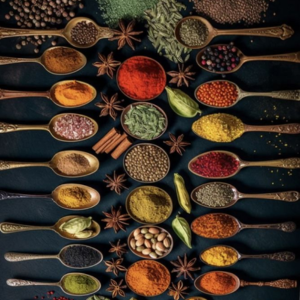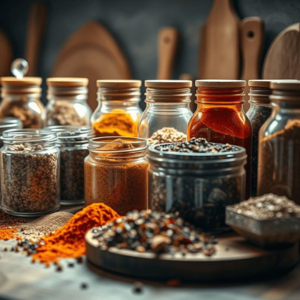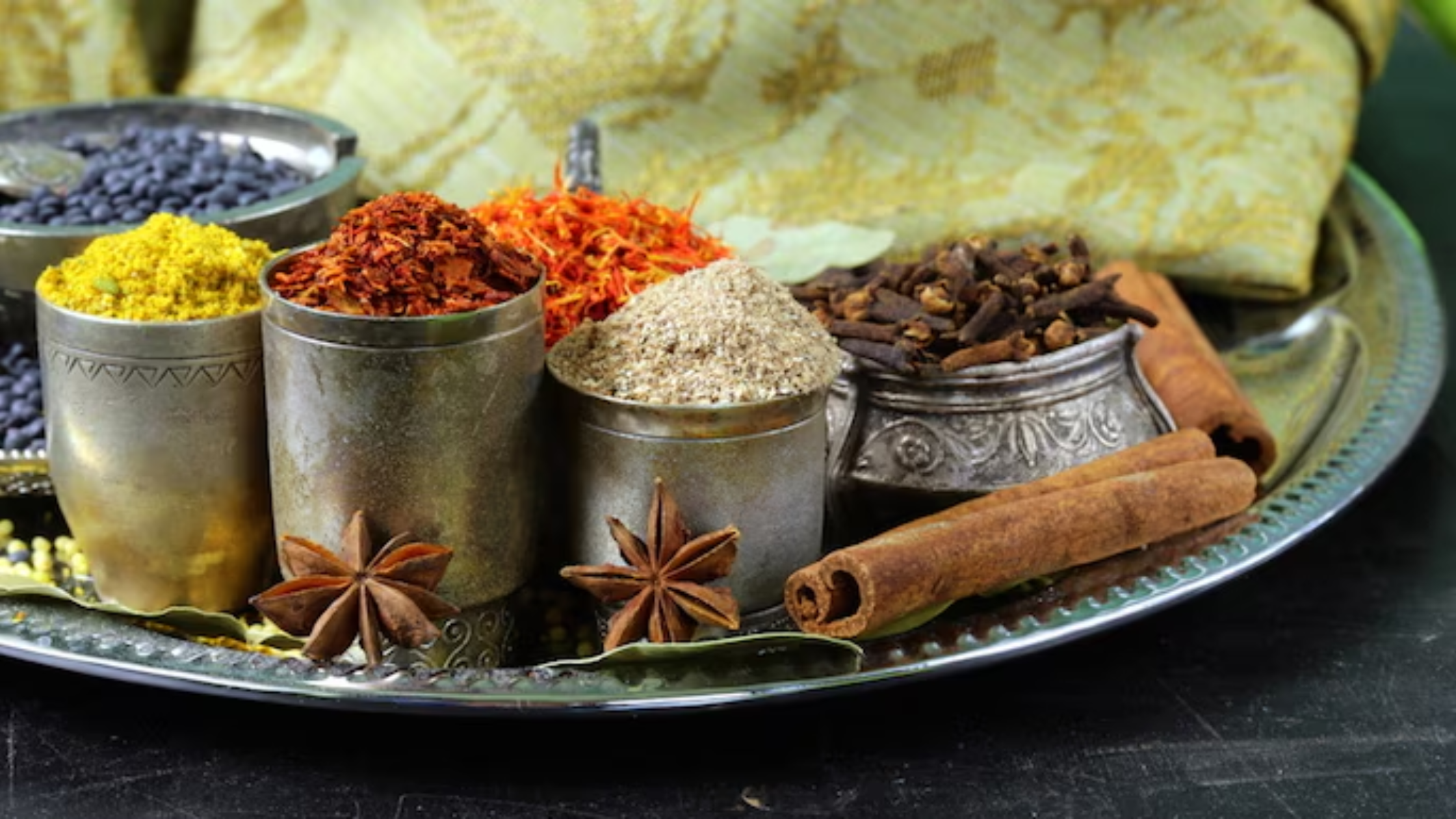Indian cuisine is celebrated for its vibrant, bold flavors, and at the heart of this culinary marvel is the generous use of spices. Whether you are a seasoned chef or a curious newcomer eager to experiment with Indian cooking, having the right spices at your fingertips is crucial for infusing authenticity and depth into your dishes. In this guide, we will delve into the top 10 essential Indian spices, highlighting their unique characteristics and their diverse roles in many Indian recipes.


Turmeric (Haldi)
Turmeric is one of the most iconic and revered spices in Indian kitchens. With its striking golden hue and warm, earthy flavor, turmeric not only enhances the color of your dishes but also imbues them with a rich, complex taste. Known for its powerful health benefits, including anti-inflammatory properties, turmeric is a staple in everything from lentil soups (dal) to fragrant vegetable curries.
Key Uses:
1.Curries (such as aromatic chicken curry or comforting dal)
2.Rice dishes like fragrant biryani and spiced pilaf
3.Smoothies and soothing drinks like golden milk for a health boos
2. Cumin (Jeera)
Cumin is a cornerstone of Indian spices, delivering a distinctive earthy and slightly nutty flavor that enhances a myriad of dishes. Available in both whole seeds and ground form, cumin is often toasted to release its aromatic oils, creating a robust base for curries and spice blends, including the beloved garam masala.
Key Uses:
1. Moroccan-inspired cumin rice
2.Flavorful vegetable curries and hearty dal
3.Essential spice blends, such as garam masala and zesty chaat masala
3. Coriander (Dhania)
Coriander is a remarkably versatile spice that lends itself well to an array of culinary creations. Both the seeds and fresh leaves (cilantro) find their way into numerous dishes. The seeds offer a refreshing, slightly sweet citrus flavor that shines in curry powders and spice mixes, while fresh cilantro adds vibrant notes and a pop of color to curries, salsas, and chutneys.
Key Uses:
1. Rich, warming curries and fragrant dal
2. Fresh chutneys and zesty salsas
3. Piquant garnish for tacos, biryani, and more for a fresh touch
4. Garam Masala
Garam masala is a hallmark of Indian cooking, featuring a delightful blend of ground spices such as cumin, coriander, cinnamon, cloves, and cardamom. This aromatic mixture is typically added towards the end of cooking, allowing the spices to meld beautifully and create mouthwatering complexity in dishes. Each region in India boasts its variation of garam masala, making it an indispensable ingredient for authentic Indian fare.
Key Uses:
1.Decadent curries (like creamy butter chicken or tender lamb curry)
2.Rich, flavorful stews and hearty soups
3.A finishing touch sprinkled on roasted vegetables for enhanced flavor
5. Mustard Seeds (Rai)
Mustard seeds are small yet mighty, playing an essential role in Indian culinary traditions. These tiny seeds pop and sizzle when heated, releasing a sharp and slightly bitter essence that adds excitement to dishes. They are particularly prominent in South Indian cuisine, where they are commonly used to create a flavorful tadka (tempering) for sautéed vegetables and legumes.
Key Uses:
1.Flavor-packed vegetable curries
2.Essential in tadka for dal, creating a fragrant base
3.Spicy pickles and zesty chutneys full of character
6. Cardamom (Elaichi)
Cardamom is a cherished spice known for its complex, sweet, and floral aroma, enchanting all who encounter it. Often referred to as the “queen of spices,” cardamom comes in two varieties: green cardamom, the most common in Indian cooking, and black cardamom, with its bold, smoky flavor. This spice bridges the sweet and savory, making it an essential component in various dishes.
Key Uses:
1.Indulgent desserts like creamy kheer (rice pudding) and syrupy gulab jamun
2.Fragrant biryanis and flavorful pulaos
3.Infusing chai tea with its signature warm, inviting flavor
7. Chili Powder (Lal Mirch)
Chili powder is the fiery heart of Indian cuisine, igniting dishes with its heat and vibrant color. A must-have for spice lovers, this ingredient can be adjusted to suit your preferred heat level. Among the various types available, Kashmiri chili powder is particularly noteworthy for its deep red color and moderate heat, making it an excellent choice for creating visually stunning dishes without overwhelming spice levels.
Key Uses:
1.Spicy curries and richly flavored sauces
2.Grilled tandoori dishes bursting with flavor
3.Cooling raita (yogurt-based side dish) to counterbalance heat
8. Fenugreek (Methi)
Fenugreek has a unique flavor profile, characterized by its slightly bitter and nutty taste. Used in both its seed form and as fresh leaves, fenugreek imparts a distinctive depth to various dishes. The seeds are often added to curries, while the fresh leaves are prized in dishes like methi thepla, a famous Gujarati flatbread, showcasing the spice’s versatility.
Key Uses:
1.Flavorful curries and heartwarming vegetable dishes
2.Tangy pickles bursting with character
3.Soft flatbreads like methi paratha for a delightful twist
9. Asafoetida (Hing)
Asafoetida, known as hing, is a pungent spice with an unparalleled ability to enhance flavors, especially in vegetarian dishes. When used sparingly, this potent spice transforms dishes with its savory notes and earthy aroma. Often included in the tempering process for dal and sautéed vegetables, hing may have an off-putting scent raw, but its cooked form presents a rich, umami experience.
Key Uses:
1.Flavorful dal tadka that warms the soul
2.Delectable vegetarian curries and mixed vegetable dishes
3.Vibrant chutneys and tangy pickles for a flavor boost
10. Fennel Seeds (Saunf)
Fennel seeds are sweet, aromatic seeds with a hint of licorice, making them a delightful addition to both savory dishes and desserts. Their pleasant aroma and slightly crunchy texture enhance vegetable preparations and fragrant rice dishes. Fennel seeds are also commonly enjoyed as a post-meal digestive, known for their soothing qualities.
Key Uses:
1.Fragrant rice dishes such as jeera rice
2.Flavorful curries and vegetable preparations
3.A refreshing post-meal digestive to aid digestion
By incorporating these essential spices into your kitchen, you can elevate your cooking, creating authentic Indian dishes that tantalize the taste buds and warm the heart. Embrace the colorful world of Indian spices and let your culinary journey begin!


Leave a comment